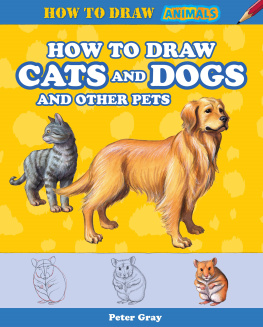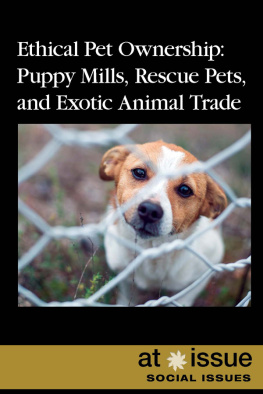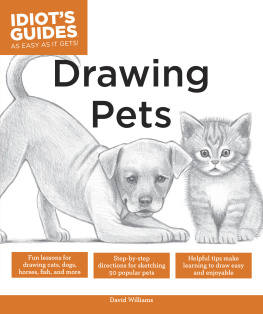The Science of Pets
From the Editors of Scientific American
Cover Image: StockImage/Getty Images
Letters to the Editor
Scientific American
One New York Plaza
Suite 4500
New York, NY 10004-1562
or editors@sciam.com
Copyright 2017 Scientific American, a division of Nature America, Inc.
Scientific American is a registered trademark of Nature America, Inc.
All rights reserved.
Published by Scientific American
www.scientificamerican.com
ISBN: 978-1-4668-5901-2


OUR FURRY FRIENDS:
The Science of Pets
From the Editors of Scientific American
Table of Contents
Introduction
by Dawn Stover
Section 1
1.1
by Daisy Yuhas
1.2
by Karen Schrock Simring
1.3
by dm Miklsi
1.4
by Scott O. Lillienfield and Hal Arkowitz
Section 2
2.1
by Virginia Morrell
2.2
by Gareth Cook
2.3
by Julie Hecht
2.4
by Marc Bekoff and Jessica Pierce
2.5
by Julie Hecht
2.6
by David J. Waters and Kathleen Wildasin
Section 3
3.1
by Carlos A. Driscoll, Juliet Clutton-Brock, Andrew C. Kitchener and Stephen J. OBrien
3.2
by Kate Wong
3.3
by Julia Calderone
3.4
by David Biello
3.5
by Paul Miller
3.6
by Jessica P. Hekman
3.7
by Gustavo Arrizabalga and Bill Sullivan
Section 4
4.1
by Frans B. M. de Waal
4.2
by Barbara J. King
4.3
by Katherine Harmon Courage
4.4
by Steve Mirsky
Dog Days and the Cat's Meow
The kitten loitering outside my local firehouse was still there two hours later,yowling with hunger, when the community council meeting I was attendingbroke up. Will you take him home? asked my neighbor. My friend Stevewants to adopt a cat, so it would just be for one night. Of course, I would. Butthe next day I learned Steve wanted a tabby, and this kitten had a coat as softas a rabbits but no stripes. Your loss, Steve. Bunny Boy, now 12 years old and still with me,is my favorite cat ever. Thats saying a lot, considering how many pets have shared myhome over the years.
At the moment, my husband and I have three cats and two dogs, and I consider myself a catperson and a dog person. There are no hard-and-fast rules, though, about what makes someonea typical owner of either species, as What Your Pet Reveals about You explains.In fact, cats and dogs often come into our lives in unexpected ways. They also come in allshapes and shadesa reflection of how their evolution has been affected by human contact,a process described in From Wolf to Dog and The Taming of the Cat.
When I was a college student majoring in biology more than 30 years ago, ascribing humanemotions and motives to animalsanthropomorphismwas frowned on. Today, though,many scientists feel comfortable saying what we pet owners have known all along: that animalsfeel things. Even rats have empathy for their cage mates, and creatures of many speciesapparently grieve over the loss of relatives or close companionsas we learn in Do AnimalsFeel Empathy? and When Animals Mourn. Yet recent research highlightedin The World According to Dogs also shows that pet owners often misinterprettheir charges feelings.
Pets fill our own emotional need to nurture other living things, making us healthier andhappier, according to Pets: Why Do We Have Them?. Canine companions mayeven help in the effort to cure cancer, as described in Cancer Clues from Pet Dogs. Indoor cats, meanwhile, might not deserve the bad rap theyre getting for spreading abrain-altering parasite to humansa surprise reported in Played by a Parasite.
More than half of American households have a petusually more than one and often consideredmembers of the family. They bring us joy, occasional sadness (if only because theirlives are measured in dog years) and now an unending source of viral videos. Read on to learnwhy dogs and cats behave the way they do and what makes the human-pet bond so strong.
--Dawn Stover
Book Editor
SECTION 1
For the Love of Pets
Pets: Why Do We Have Them?
by Daisy Yuhas
On my 10th birthday, I got a puppy, I was so shockedI had wanted a dog for as long as I could rememberand so overwhelmed with happinessthat I burst into tears. For the next 14 years, Happy, a beagle, charmedeveryone he met. And when he passed, all of us who had known himmourned, as we would for any loved one. More than half of Americanhouseholds have a petthat is, an animal kept primarily for companionship.And despite the fact that these housemates may bear scales, fur,fins or feathers, people often view their animals as family members. In 2014 we spent an estimated$58 billion on our animal companions and untold hours caring for them.
For 50 years psychologists have beentrying to unravel the appeals of animalcompanionship in hopes of decipheringjust why we invest so much in these creatures.In the process, anthrozoologistsscientists who study human-animal relationshipshave discovered a windowinto human sociality more broadly. Ourinteractions with animals can be usefulmodels for understanding how issues ofidentity, nurturing, support and attachmentplay out in a relationship. Its allabout human psychology, says anthrozoologistPauleen Bennett of La TrobeUniversity in Australia. Pets help us fillour need for social connectedness.
Although the motivations for pet ownershipmay vary as much as a golden retrieverand a goldfish, scientists are findingthat some common threads tie peopleto their household pets. Our at traction toanimals may be subconscious, driven bybiological and social forces that we do notfully acknowledge. In addition, the emotionalbond be tween pets and their ownerscan bring varied benefits, from loweredstress to novel adventures. The morewe uncover about our companion animals,the more we may learn about ourhuman attachments as well.
INBORN ATTRACTION?
Part of or attraction to animal companionshipis innate. In 2013 psychologistVanessa LoBue of Rutgers Universityand her colleagues revealed that toddlersone to three years old spend more timeinteracting with live animalswhetherfish, hamsters, snakes, spiders or geckosthan they do with inanimate toyswhen given a choice between the two.
Humans even have specialized braincells for recognizing animal life. Researchersled by Christof Koch of the AllenInstitute for Brain Science in Seattle(he also serves on Scientific AmericanMinds board of advisers) have found neuronsin the amygdala, an area involved inemotions, that respond preferentially toanimal images. The 2011 finding hints at aneural basis for the powerful emotionalreactions animals elicit from us.
Many animals seem to tap into humansattraction to the adorable, a drivethat also may motivate good parenting.Behavioral researchers have long noticedthat humans seem to have inborn,positive responses to beings with characteristicstypical of human infantssuch as wide eyes, broad foreheads andlarge head-to-body ratios.
To better understand the responsesthat cuteness can elicit, psychologist HiroshiNittono and his colleagues at HiroshimaUniversity in Japan published aseries of experiments in 2012 in whichcollege students, 132 in all, searched for adigit in numerical matrices or lifted tinyobjects from small holes using tweezers.Afterward, participants viewed a seriesof photographs before attempting the attentionor motor task for a second time.






















